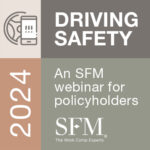Employees are at higher risk of injuries during their first six months on the job, according to SFM claim data.
Effectively training new employees on safety can be challenging, but it’s key to protecting and retaining quality employees.
Investing in a quality new-hire safety training program pays off by helping you:
- Take care of your employees
- Control your workers’ compensation premiums
- Avoid Occupational Safety and Health Administration penalties
Planning initial safety training
Your first step is to determine what topics you’ll need to cover.
You’ll want to cover both general hazards, which are applicable to all employees, and job-specific hazards. To identify these risks, conduct general hazard assessments and job-specific assessments. A Job Hazard Analysis, also known as a Job Safety Assessment, should be conducted by someone familiar with the department, workstation and tasks to be performed.
Don’t forget to include the following topics in your new hire safety training:
- Regulatory required training
- General (non-regulatory) training
- Local policies
- Incident reporting
- Return to work
- Emergency response
- Safety committee
- Safety awareness methods
- Right to refuse work or stop job if unsafe or not trained
Appropriate safety training methods are not only necessary to meet regulatory requirements; they are the key to long-term success in reducing potential employee risk. Incorporating a variety of training methods increases employees’ learning retention.
Shadow/mentor training
New employees need to thoroughly understand how to work safely after going through initial and job-specific training. Job shadowing an experienced employee provides an opportunity to learn expectations, observe safe work practices and ask questions to safely become familiar with their new position. A mentor can shadow them to assess whether correct procedures are followed and provide education or feedback.
Refresher training
You can use a safety training matrix to coordinate ongoing, periodic training for your employees.
Start by adding required topics to the matrix. Remaining topics may vary but should include the following:
- Potential hazards
- Injury trends
- Near-miss reports
- Company safety and claims policy reviews
Safety training checklist
SFM developed a simple safety training checklist to help employers determine what to include. It covers basic topics such as:
- Company safety philosophy
- Emergency response – alarms, exits, etc.
- Return-to-work
- PPE requirements
- Compliance-related training
- Procedures that address workplace hazards
- Tools and equipment that support safety
- Behaviors and/or techniques to work safely
- Policies that relate to safety
- Reporting unsafe condition or behavior
- Safety committee members and meetings (if applicable)
- Mentorship program/buddy system
Download our safety training checklist.
Observations
New hire safety orientation programs are most effective when paired with training and periodic safety observations by an experienced mentor or supervisor. Employees should be given expectations and held accountable by their leader to meet them. Consider check-ins at various intervals to assess whether the new employee can work independently to reassure the employee that the employer truly cares about their safety and elevate safety culture within the organization.
Don’t forget leadership training
Employees look to leaders and follow their examples, so it is crucial to include safety as a part of a leader’s onboarding training. Include the following topics in your safety training for leaders:
- Commitment to safety culture
- Goal setting
- Investing in safety
- Work comp 101
- Communication styles
Additional resources
Our Safety Orientation Success Guide is available in our resource catalog. It provides a solid framework that can be used to develop training, help ensure workplace safety regardless of industry, and increase productivity over time.
You can also find a library of helpful safety training resources for a variety of industries on the safety page. Click on “Employee safety orientation” to find resources organized by industry.
“Many companies that I work with really want to keep their employees safe from day one, but simply need some guidance as to what a basic new hire orientation would look like,” said SFM Loss Prevention Specialist Toby Tortorilla. “This new resource is a great reference for businesses of any size, to either start fresh or build upon an existing program.”
Originally published in April 2023; updated in August 2024.

